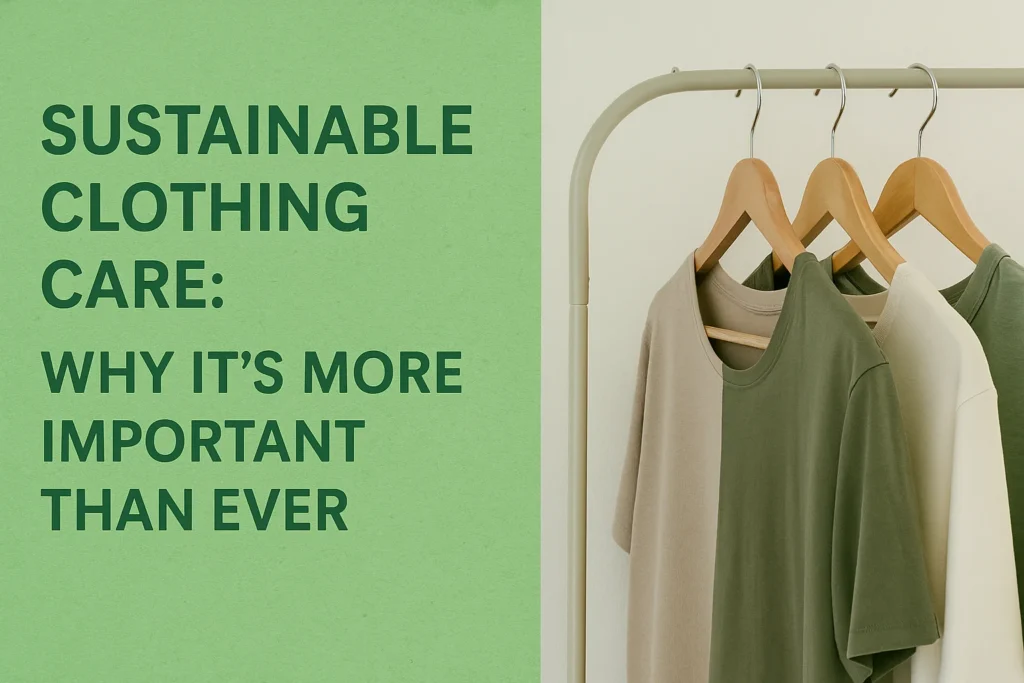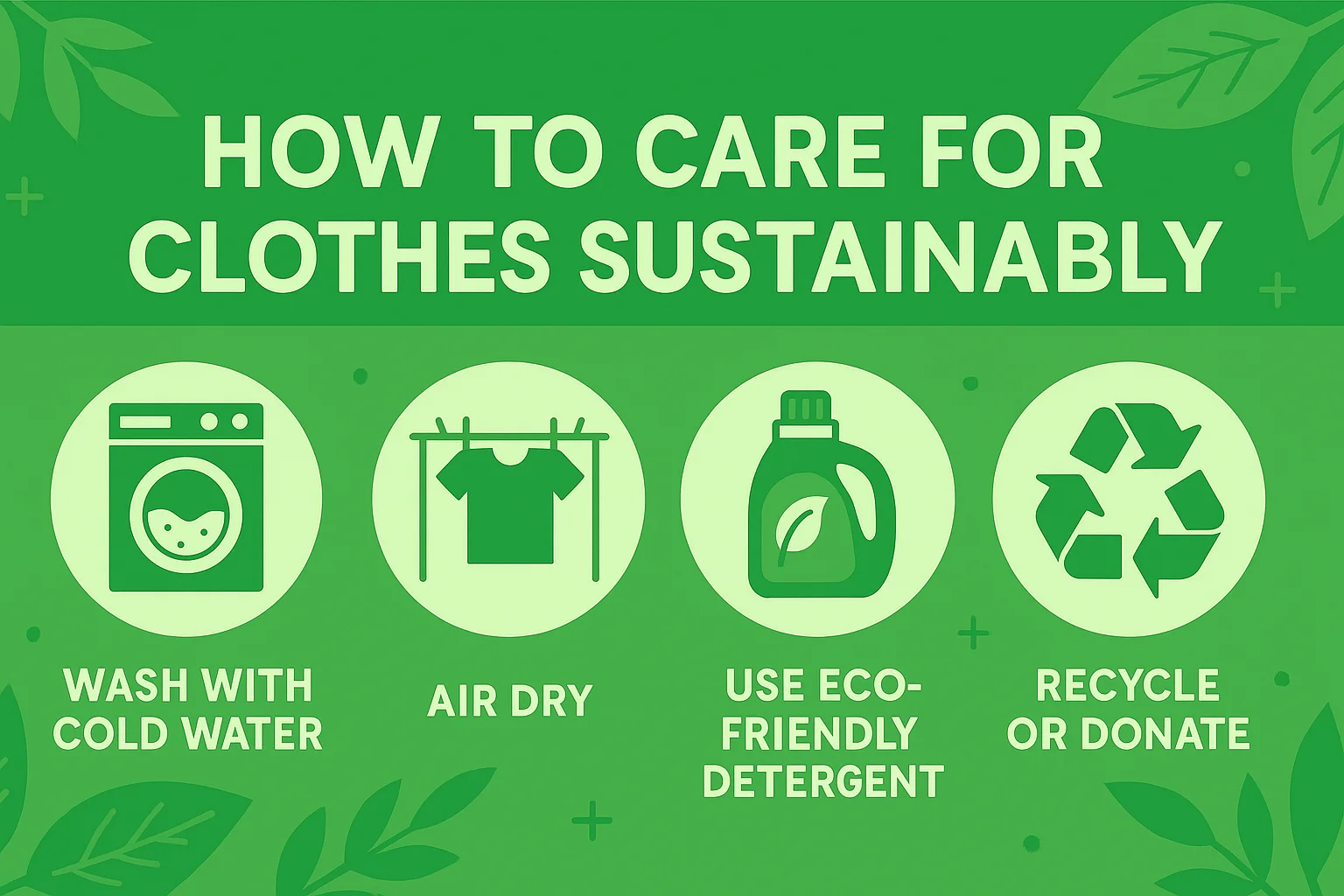Your wardrobe could be costing the planet more than you think. From the electricity used in every wash cycle to the synthetic fibers that end up in oceans, the way we care for our clothes has a ripple effect far beyond our homes. The good news? Small changes in your laundry habits can have a huge environmental payoff.
With practical tips from Eco Gear Guides, this is your complete roadmap to keeping clothes looking sharp, feeling fresh, and lasting years longer—while lowering your eco-footprint.
Sustainable Clothing Care: Why It’s More Important Than Ever

You’ve heard about buying “better, not more,” but sustainable clothing care is the missing piece of the fashion puzzle. According to the Ellen MacArthur Foundation:
- Extending clothing life by just 9 extra months can cut its environmental impact by 20–30%.
- Washing a single load of synthetics can release up to 700,000 plastic microfibers into the water supply.
Bottom line: The way you treat your clothes after you buy them is just as important as where you buy them.
Think Like a Curator, Not a Launderer
Every time you wash clothes, you put them under mechanical stress—fiber breakage, color fading, and shrinkage are all byproducts of over-washing.
Practical Shift:
- Create a “rewear rail” in your closet for clothes that are clean enough to wear again.
- Air out garments outdoors for 20–30 minutes to neutralize odors.
- Use a natural fabric spray made from distilled water + lavender oil.
Case Study:
Ali, a content creator from Islamabad, cut his laundry cycles in half by adopting a rewear system. He saved on electricity bills, extended the life of his favorite shirts, and reduced water use by over 1,500 liters in a year.
Switch to Climate-Friendly Washing
Cold water isn’t just “okay”—it’s often better. Heat accelerates dye bleeding, weakens fabric fibers, and eats up energy.
| Wash Temp | Energy Use | Best For |
|---|---|---|
| Hot (60°C) | High | Heavily soiled whites |
| Warm (40°C) | Medium | Towels, sheets |
| Cold (30°C) | Very Low | Everyday clothes, bright colors |
Eco Gear Guides Insight:
For stubborn stains, pretreat the affected area with a stain-removal paste (baking soda + water) before a cold wash. This avoids a full hot cycle while keeping the fabric safe.
Master Gentle Drying
Dryers are convenience champions but sustainability villains. They speed up fabric wear and guzzle electricity.
Alternatives:
- Indoor drying racks in sunny spots.
- Outdoor clotheslines for natural disinfecting under UV light.
- Flat drying for wool and knits to prevent stretching.
Unique Hack:
Place clothes on a clean, dry towel, roll them up tightly, and press—this absorbs excess water and cuts air-drying time in half.
Learn the Art of Proactive Repairs

A tiny rip left unrepaired quickly becomes an unfixable tear. Mending skills are a key part of sustainable fashion.
- Keep an “emergency repair kit” in your laundry area.
- Learn visible mending—a decorative way to patch holes that adds personality to garments.
- Use iron-on patches for quick, no-sew fixes.
Example:
In Karachi, a local tailoring shop now offers a “revive your favorite piece” service—clients bring in worn clothes for restyling instead of replacing them.
Store Clothes Like They’re Investments
If clothes could talk, they’d beg for better storage.
Storage Rules:
- Use breathable fabric bags for delicate dresses and suits.
- Cedarwood blocks over mothballs—they repel pests without harmful fumes.
- Keep clothes in a cool, dry place away from direct sunlight.
Eco Gear Guides Tip:
Rotate hanging garments every few months to avoid permanent hanger marks on shoulders.
Read More : What Is Slow Fashion and Why Does It Matter?
Debunking Sustainable Clothing Care Myths
| Myth | Reality |
|---|---|
| “Dry cleaning is always safe” | Many use toxic solvents unless specifically labeled eco-friendly. |
| “More detergent = cleaner clothes” | Excess detergent leaves residue, damaging fibers and irritating skin. |
| “Handwashing saves water” | Not always—full machine loads can be more efficient. |
How Eco Gear Guides Makes Sustainable Care Easier
From testing zero-waste laundry products to reviewing long-lasting wardrobe essentials, Eco Gear Guides offers data-backed, hands-on recommendations. We go beyond “buy this” advice—our goal is to help you own less, use longer, and waste nothing.
Conclusion: Your Wardrobe Deserves Better
Sustainable clothing care is a shift in mindset: treat clothes as valuable assets, not disposable items. Wash with intention, dry with patience, repair with pride, and store with care.
By following these steps, you’ll save money, look better, and take a meaningful stand against fashion waste—one laundry load at a time.
Read More : Sustainable Activewear That Performs
FAQs
Q1: How can I freshen clothes without washing?
Hang them in fresh air, use steam from a shower, or spray lightly with a natural deodorizing mist.
Q2: Is line-drying clothes inside bad for air quality?
Only if your home has poor ventilation. Using a fan or open window helps.
Q3: Can vinegar replace fabric softener?
Yes, white vinegar in the rinse cycle naturally softens fabric and reduces static.
Q4: What’s the easiest sustainable habit for beginners?
Start with cold washes and air-drying—it saves both fabric and resources immediately.


